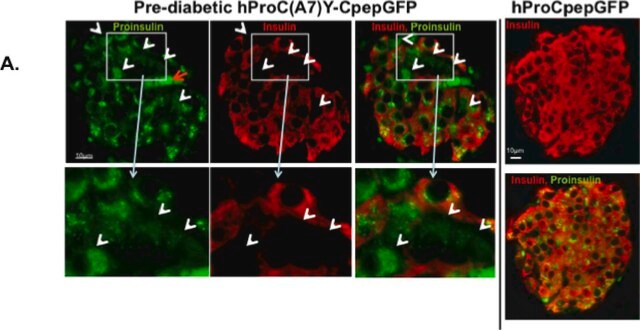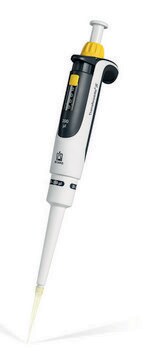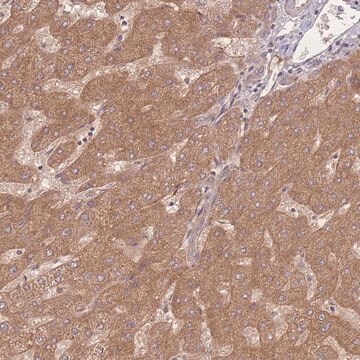一般說明
We are committed to bringing you greener alternative products, which adhere to one or more of The 12 Principles of Green Chemistry.This antibody is Preservative-free, produced without the harm or sacrifice of animals and exceptionally stable to allow for ambient shipping and storage if needed and thus aligns with "Waste Prevention", "Designing Safer Chemicals" and "Design for Energy Efficiency".
Click here for more information.
ZooMAb® antibodies represent an entirely new generation of recombinant monoclonal antibodies.Each ZooMAb® antibody is manufactured using our proprietary recombinant expression system, purified to homogeneity, and precisely dispensed to produce robust and highly reproducible lot-to-lot consistency. Only top-performing clones are released for use by researchers. Each antibody is validated for high specificity and affinity across multiple applications, including its most commonly used application. ZooMAb® antibodies are reliably available and ready to ship when you need them.
特異性
Clone 1J16 is a Rabbit recombinant monoclonal antibody that specifically detects Insulin receptor. It targets an epitope within 17 amino acids from the C-terminal cytoplasmic domain of the b-subunit.
免疫原
KLH-conjugated linear peptide corresponding to 17 amino acids from the C-terminal, cytoplasmic domain of human Insulin receptor b-subunit.
應用
Quality Control Testing
Evaluated by Western Blotting in rat liver tissue lysate.
Western Blotting Analysis: A 1:1,000 dilution of this antibody detected Insulin Receptor β in rat liver tissue lysate.
Tested applications
Western Blotting Analysis: A 1:1,000 dilution from a representative lot detected recombinant human Insulin Receptor β and Insulin Receptor b in lysates from Human Kidney and NIH3T3 and U2OS cells.
Immunocytochemistry Analysis: A 1:1,000 dilution from a representative lot detected Insulin Receptor β in U2OS cells.
Affinity Binding Assay: A representative lot of this antibody bound Insulin Receptor b with a KD of 2.2 x 10-7 in an affinity binding assay.
Immunohistochemistry (Paraffin) Analysis: A 1:100 dilution from a representative lot detected Insulin Receptor β in human kidney tissue sections.
Note: Actual optimal working dilutions must be determined by end user as specimens, and experimental conditions may vary with the end user
標靶描述
Insulin receptor (UniProt: P06213; also known as EC:2.7.10.1, IR, CD220) is encoded by the INSR gene (Gene ID: 3643) in human. Insulin is the major hormone that counters the concerted action of a number of hyperglycemia generating and enhances glucose uptake in muscle and adipose tissue, and reduces gluconeogenesis and lipolysis. Its actions are mediated via binding to the Insulin receptor. Insulin receptor is a single-pass type I membrane glycoprotein that is synthesized with a signal peptide (aa 1-27), which is subsequently cleaved off to generate the mature form. It is a tetrameric receptor composed of two a and two β chains linked by disulfide bonds. The a chains carry the insulin-binding region, while the β chains carry the kinase domain. Upon insulin binding, the receptor undergoes autophosphorylation that activates its kinase activity localized in the β subunit. The tyrosine kinase activity then leads to phosphorylation of several intracellular substrates, including, insulin receptor substrates (IRS1, 2, 3, 4), SHC, GAB1, CBL and other signaling intermediates. These phosphorylated proteins serve as docking proteins for other signaling proteins that contain SH2 domains that specifically recognize different phosphotyrosine residues, including the p85 regulatory subunit of PI3K and SHP2. Phosphorylation of IRSs proteins lead to the activation of the PI3K-AKT/PKB pathway, which is responsible for most of the metabolic actions of insulin, and the Ras-MAPK pathway, which regulates expression of some genes and cooperates with the PI3K pathway to control cell growth and differentiation. Upon insulin binding the receptor undergoes autophosphorylation that activates its kinase activity localized in the β subunit. This ZooMAb® recombinant monoclonal antibody, generated by our propriety technology, offers significantly enhanced specificity, affinity, reproducibility, and stability over conventional monoclonals.
外觀
Purified recombinant rabbit monoclonal antibody IgG, lyophilized in PBS, 5% Trehalose, normal appearance a coarse or translucent resin. The PBS/trehalose components in the ZooMAb formulation can have the appearance of a semi-solid (bead like gel) after lyophilization. This is a normal phenomenon. Please follow the recommended reconstitution procedure in the data sheet to dissolve the semi-solid, bead-like, gel-appearing material. The resulting antibody solution is completely stable and functional as proven by full functional testing. Contains no biocide or preservatives, such as azide, or any animal by-products. Larger pack sizes provided as multiples of 25 μL.
重構
300 μg/mL after reconstitution at 25 μL per vial. Please refer to guidance on suggested starting dilutions and/or titers per application and sample type.
儲存和穩定性
Recommend storage of lyophilized product at 2-8°C; Before reconstitution, micro-centrifuge vials briefly to spin down material to bottom of the vial; Reconstitute each vial by adding 25 μL of filtered lab grade water or PBS; Reconstituted antibodies can be stored at 2-8°C, or -20°C for long term storage. Avoid repeated freeze-thaws.
法律資訊
ZooMAb is a registered trademark of Merck KGaA, Darmstadt, Germany
免責聲明
Unless otherwise stated in our catalog or other company documentation accompanying the product(s), our products are intended for research use only and are not to be used for any other purpose, which includes but is not limited to, unauthorized commercial uses, in vitro diagnostic uses, ex vivo or in vivo therapeutic uses or any type of consumption or application to humans or animals.







